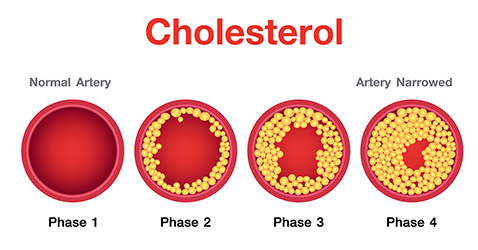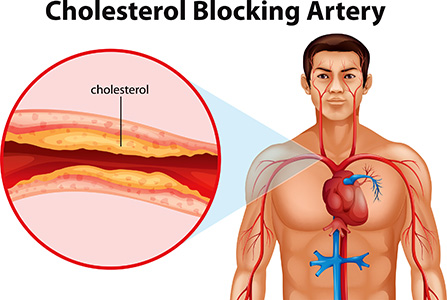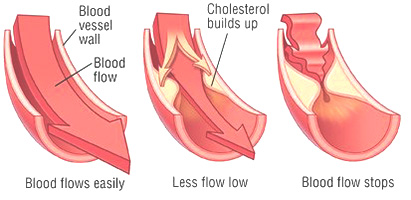Cholesterol is the mortar of all tissues produced in the liver and brain, but is it right to use drugs when it's high?
Cholesterol is a very controversial issue in the scientific world. The discussion of cholesterol is due to the association of this substance with cardiovascular diseases. Is it really so, is cholesterol the enemy?
Cholesterol is a Lipoprotein. In other words, it is a waxy substance consisting of one molecule of fat and one molecule of protein. It is abundant in almost all animal foods, especially eggs. With these foods eaten, cholesterol passes into the blood. But the majority of cholesterol, almost seventy-five percent, is produced by the liver.

Essentially, cholesterol is a vital substance found in the structure of all cells. It is involved in the structure of many hormones, especially Testosterone and Estrogen. Cholesterol is essential for vitamin D produced in the skin. 20-25% of the brain consists of cholesterol, all of which is produced in the brain. Bile acids, which are essential for digestive activities, are produced from cholesterol. In short, cholesterol is the mortar of all tissues. If cholesterol were not beneficial, it would not be produced in the liver and brain.
There is no good or bad cholesterol taken with food, cholesterol is always the same cholesterol, but the situation changes when cholesterol enters the blood. Here, too, the cholesterol is essentially the same cholesterol, but when the carriers are different, it performs different functions.
There are two forms of cholesterol that are divided into good and bad, the first of which is good cholesterol HDL, this cholesterol is the type of cholesterol that takes the blood from the tissues and vessels to the liver for reprocessing. The second type is LDL, bad cholesterol, the task of this cholesterol is to carry the cholesterol it receives from the liver and blood to the tissues. In fact, this cholesterol has very important functions, because the tissues need the cholesterol it carries. However, when this LDL Cholesterol is oxidized, it settles in the veins. That's why LDL cholesterol is called bad.

It is said that the total cholesterol level in the blood should be below 200 milligrams deciliter (200 mg/dl). However, this figure is an imprecise figure, because there are many people with very high cholesterol who do not have any cardiovascular disease, and there are many people with severe coronary artery disease who have normal or even lower cholesterol. As it is often mentioned, the total cholesterol level is not that important, the important thing is the ratio of total cholesterol to good cholesterol. This is called the HDL ratio.

For example, if total cholesterol is 200, which counts as a reasonable number, good cholesterol is 50 in HDL, and 200 divided by 50 equals 4. Studies show that rates below 5 are healthy, and rates above 5 are unhealthy. In another example, if the total cholesterol is still 200 but the good cholesterol is low, 30, then the resulting ratio would be 6.67, which is well above 5. Rates above 5 pose a risk for Cardiovascular Diseases. From this it should be understood that the ratio of good cholesterol HDL is much more important than the total cholesterol itself.
Detailed reading:
Rethinking dietary cholesterol,
Cholesterol intake and plasma cholesterol: an update,
Dairy Fats and Cardiovascular Disease: Do We Really Need to Be Concerned?
75 percent of the cholesterol in our blood is produced in the liver, and only 25 percent comes from food. Scientific studies show that the cholesterol taken with food does not increase the blood cholesterol level too much, and this increase does not increase the risk of cardiovascular diseases. There is an interesting explanation for this, the cholesterol that sits in the arteries is the bad cholesterol, LDL. There are two types of LDL, small molecule LDL and large molecule LDL. Cholesterol taken with food begins to circulate in the blood as large molecule LDL and this molecule cannot settle in the vessels. On the other hand, small molecule LDL is made in the liver and this is caused by excessive intake of sugar, alcohol and carbohydrates. The dangerous bad cholesterol is small molecule LDL.
Detailed reading:
The role of small, dense low density lipoprotein (LDL): a new look
The answer to the question of why small molecule LDL, which causes cholesterol to settle in the arteries, sits in the veins of some people and not in the veins of other people, is the
inflammation in the body. To summarize briefly, the factors that cause inflammation are smoking, trans fats,
diabetes,
obesity, chemicals in processed foods, and stress.
Inflammation is a germ-free inflammatory formation that affects all tissues, especially vessels. Inflammation grabs and damages the inner layer of our vessels, called the endothelium, which is extremely sensitive. Cholesterol begins to come to that area to repair the damaged tissue. In short, if there is no inflammation, cholesterol does not come to settle and repair the vessels. Therefore, smokers, obese people, diabetics are at risk for coronary artery disease and other vascular diseases caused by inflammation and bad cholesterol.
Some foods are rich in Cholesterol,
- About 200 mg in an
Egg,
- 50 mg in 50 grams of Cheese,
- 200 mg per 100 grams of Shrimps, Mussels,
- 200 mg per 100 grams of Offal,
- 100 mg per 150 g of Veal Meat (a little more in Mutton)
- 200 mg per 100 grams of Butter,
- 75 mg in 150 grams of Creamy Ice Cream,
- 30 mg in 150 grams of full-fat
Yogurt.
It is unclear how much it is in foods such as fast food!
Former recommendations of the US Department of Health recommended that healthy people take no more than 300 milligrams of cholesterol per day, and those at risk of heart disease should limit their cholesterol intake to 200 milligrams per day. However, scientific studies conducted over the years have shown that dietary cholesterol does not have much effect on blood cholesterol levels, and this cholesterol does not have a significant effect on cardiovascular diseases.
Detailed reading:
Dietary Cholesterol and the Lack of Evidence in Cardiovascular Disease
On the other hand, when cholesterol intake is restricted, the liver increases cholesterol production to compensate for this deficit.
Detailed reading:
Dietary Cholesterol Feeding Suppresses Human Cholesterol Synthesis Measured by Deuterium Incorporation and Urinary Mevalonic Acid Levels
As a result of these scientific studies, the American Ministry of Health has changed its dietary recommendations on cholesterol since 2015. These new recommendations are shaped as follows:
- It does not impose a restriction on cholesterol intake, but it should be used in moderation,
- Consumption of saturated fats from animal foods as little as possible,
- 5-10% of daily calorie intake comes from healthy unsaturated fats,
- Absolute avoidance of trans fats,
- Restriction of sugar consumption due to the negative effects of
sugar consumption on blood cholesterol status.
However, as in all matters, it is of great benefit to be moderate in the consumption of cholesterol and animal foods. Foods rich in cholesterol are also very rich in saturated fats and protein. It should not be forgotten that these substances also cause significant harm.
For a reasonable and moderate consumption of cholesterol,
- One egg a day,
- An average of 100 grams of meat per day,
- Maximum 50 grams of cheese per day,
- Offal at most 1 time per week,
- Up to 25 grams of butter per day,
- Milk dessert or ice cream should be eaten at most 2 days a week.
But it should also be known that in the twenties and thirties, taking cholesterol in excess of this amount may not cause any harmful side effects. However, even eating half of the same amount of cholesterol can cause significant harmful effects in people in their 40s and 50s, depending on aging.
Foods that help lower Cholesterol
"
Statin" Cholesterol-lowering drugs come to mind first when it comes to cholesterol treatment. Many physicians all over the world immediately start these drugs if the total cholesterol value is above 250 and the bad cholesterol LDL is high. Few physicians take the time to tell their patients about the effects and remedies of lifestyle on cholesterol. Usually the first step is to start treatment with medication.
Do these drugs lower cholesterol? Yes, but how? Cholesterol-lowering statin drugs prevent the production of cholesterol in the liver by blocking an enzyme called "HMG-CoA". Although it varies from person to person, the use of statin drugs can reduce the cholesterol level by 20-50%, that is, if the total cholesterol is 300, it can be reduced to 200 or even lower. But the question is, does lowering cholesterol have a positive effect on cardiovascular diseases? After all, the only purpose of using these drugs is to prevent cardiovascular diseases by lowering cholesterol!
Pharmaceutical companies and industry-supported scientific studies claim that long-term use of cholesterol medication provides a 48% reduction in the risk of cardiovascular diseases and stroke. As it is said that statistics is the art of lying scientifically, there is a similar situation here. When we look at the figures, a decrease of 48% means that the risk, which is actually 28 per thousand, is reduced to 15 per thousand. The actual risk reduction is 1.3%, and the first figure of 48% is called Relative Risk Reduction (RRR). On the other hand, the figure of 1.3% is called Absolute Risk Reduction (ARR). In summary, the risk reduction obtained with long-term use of these drugs is only 1.3%, a rate that is not worth considering.

It seems that many of the patients who come to surgery for coronary artery disease have been using statin drugs for many years, and at least half of these patients have completely normal cholesterol levels, so having a low cholesterol did not save these patients from undergoing surgery. On the other hand, there are many people whose cholesterol is much higher, at the level of 300 - 400, and who do not have coronary artery disease.
Back to the question, should medication for high cholesterol be used or not? At this point, it is useful to open a parenthesis. Statin drugs are the #1 drug prescribed in the world. Among the hundreds of drugs such as antibiotics, blood pressure medications, heart medications and similar drugs, the most prescribed and best-selling drugs are statin drugs. The worldwide turnover of statin drugs is approximately $1 trillion. Now think about it, what would it take for a market of this size, such a turnover! Numerous scientific publications are published every year on the effects, benefits and safety of statin drugs, but if these publications are carefully examined, it is seen that the majority of them are supported by the pharmaceutical industry. On the other hand, many independent researchers write the truth about statins but cannot make their voices heard.
Detailed reading:
How statistical deception created the appearance that statins are safe and effective in primary and secondary prevention of cardiovascular disease
While the protection of cholesterol-lowering statin drugs against heart disease is highly questionable, they also have significant side effects. According to the list of side effects written on the package insert of the drug manufacturer,
- Muscle aches and cramps,
- Muscle wasting (Rhabdomyolysis),
- Liver damage,
-
Insulin resistance and diabetes,
- Weakness,
- Nausea,
- Dizziness,
- Nerve damage (poly-neuropathy),
-
Insomnia,
- Forgetfulness,
- Bewilderment,
-
Impotence,
- Decrease in CoQ10 enzyme levels,
- Heart muscle damage,
- Heart failure
side effects may occur. Apart from these important side effects, 20 - 30 more are also listed.
Detailed reading:
Statin-Related Myotoxicity: A Comprehensive Review of Pharmacokinetic, Pharmacogenomic and Muscle Components,
Statin therapy and related risk of new-onset type 2 diabetes mellitus,
Statins Linked to Raised Risk of Type 2 Diabetes,
Statins stimulate atherosclerosis and heart failure: pharmacological mechanisms,
Coenzyme Q10 and Statin-Induced Mitochondrial Dysfunction,
Statins and Abnormal Liver Function Tests: Is There a Correlation?,
Do statins lower testosterone and does it matter?,
The effect of statin therapy on testosterone levels in subjects consulting for erectile dysfunction
Liver damage, heart muscle damage and diabetes are not acceptable side effects. Although other side effects are not that serious, they are conditions that can significantly impair quality of life and health. Side effects associated with statins are reported to be around twenty percent, in fact, this figure is estimated to be at least twice as high. When the side effects of the drug come to the fore in scientific discussions, many statin advocates argue that these side effects may occur, but the benefits are much greater, but it should be remembered that the real protection rate is only 1.3 percent. The most frightening argument is that when statin drugs come to the fore that they cause insulin resistance and diabetes, many pseudo-scientists with academic titles say that then we start giving the patient diabetes medicine. In other words, they try to fix a mistake with another mistake.
Detailed reading:
Safety and efficacy of statin therapy
So statin drugs will not be used at all? There is a significant benefit in lowering LDL cholesterol for those with diabetes, inflammation, and certain other risk factors. In these cases, statin drug use can be started for 2-3 months to these people, and it is stopped after eliminating the main risk factors with lifestyle and when they are no longer needed.
If the question of whether cholesterol should be treated or whether it is necessary to bring cholesterol to a reasonable level and a healthy balance, the answer is yes. However, it is necessary to think a lot before using statin drugs, whose benefit is questionable and whose side effects can be very severe.
High cholesterol is not a disease, but a metabolic disorder caused by lifestyle. When the factors that disrupt the metabolism disappear, everything starts to improve by itself. With serious lifestyle changes, even the most severe diseases can be paused and reversed.
While regulating Cholesterol level, boost your Nitric Oxide, Antioxidants and Omega 3 levels with
Wellness Triangle which will also prevent cell deformation, protect heart and cardiovascular health, improve immune response, and prolong your life span. After only 30 days of regular use, you will easily notice the changes on your body, but better is to get a blood test at the beginning and at the end of the cure to see all the regenerations on the results. Take action today, improve your health, enhance your life quality... tomorrow may be too late!
Wellness Triangle is the best supplement, a complete support, unique in the world, that provides a healthy living with the regular use of only 3 products.
Learn More
Back to Home








